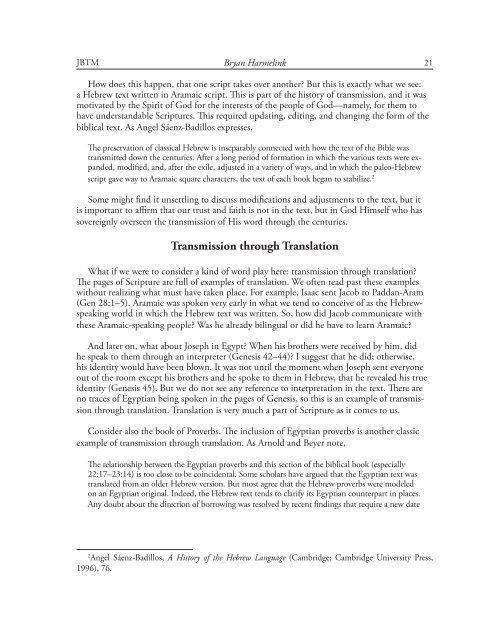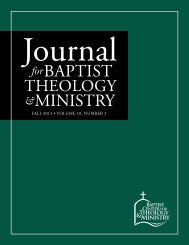Bible Translation as Missions
pTf2MG
pTf2MG
Create successful ePaper yourself
Turn your PDF publications into a flip-book with our unique Google optimized e-Paper software.
JBTM Bryan Harmelink21How does this happen, that one script takes over another? But this is exactly what we see:a Hebrew text written in Aramaic script. This is part of the history of transmission, and it w<strong>as</strong>motivated by the Spirit of God for the interests of the people of God—namely, for them tohave understandable Scriptures. This required updating, editing, and changing the form of thebiblical text. As Angel Sáenz-Badillos expresses,The preservation of cl<strong>as</strong>sical Hebrew is inseparably connected with how the text of the <strong>Bible</strong> w<strong>as</strong>transmitted down the centuries. After a long period of formation in which the various texts were expanded,modified, and, after the exile, adjusted in a variety of ways, and in which the paleo-Hebrewscript gave way to Aramaic square characters, the text of each book began to stabilize. 2Some might find it unsettling to discuss modifications and adjustments to the text, but itis important to affirm that our trust and faith is not in the text, but in God Himself who h<strong>as</strong>sovereignly overseen the transmission of His word through the centuries.Transmission through <strong>Translation</strong>What if we were to consider a kind of word play here: transmission through translation?The pages of Scripture are full of examples of translation. We often read p<strong>as</strong>t these exampleswithout realizing what must have taken place. For example, Isaac sent Jacob to Paddan-Aram(Gen 28:1–5). Aramaic w<strong>as</strong> spoken very early in what we tend to conceive of <strong>as</strong> the Hebrewspeakingworld in which the Hebrew text w<strong>as</strong> written. So, how did Jacob communicate withthese Aramaic-speaking people? W<strong>as</strong> he already bilingual or did he have to learn Aramaic?And later on, what about Joseph in Egypt? When his brothers were received by him, didhe speak to them through an interpreter (Genesis 42–44)? I suggest that he did; otherwise,his identity would have been blown. It w<strong>as</strong> not until the moment when Joseph sent everyoneout of the room except his brothers and he spoke to them in Hebrew, that he revealed his trueidentity (Genesis 45). But we do not see any reference to interpretation in the text. There areno traces of Egyptian being spoken in the pages of Genesis, so this is an example of transmissionthrough translation. <strong>Translation</strong> is very much a part of Scripture <strong>as</strong> it comes to us.Consider also the book of Proverbs. The inclusion of Egyptian proverbs is another cl<strong>as</strong>sicexample of transmission through translation. As Arnold and Beyer note,The relationship between the Egyptian proverbs and this section of the biblical book (especially22:17–23:14) is too close to be coincidental. Some scholars have argued that the Egyptian text w<strong>as</strong>translated from an older Hebrew version. But most agree that the Hebrew proverbs were modeledon an Egyptian original. Indeed, the Hebrew text tends to clarify its Egyptian counterpart in places.Any doubt about the direction of borrowing w<strong>as</strong> resolved by recent findings that require a new date2Angel Sáenz-Badillos, A History of the Hebrew Language (Cambridge: Cambridge University Press,1996), 76.



